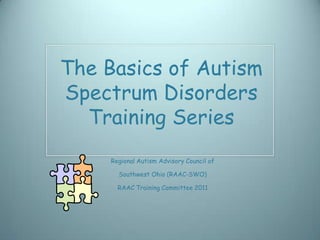
School training module fourteen,functional behavior assessme
- 1. The Basics of Autism Spectrum Disorders Training Series Regional Autism Advisory Council of Southwest Ohio (RAAC-SWO) RAAC Training Committee 2011
- 2. Training Series Modules Module One: Autism Defined, Autism Prevalence and Primary Characteristics Module Two: Physical Characteristics of Autism Module Three: Cognition and Learning in Autism Module Four: Getting the Student Ready to Learn Module Five: Structuring the Classroom Environment Module Six: Using Reinforcement in the Classroom
- 3. Training Series Modules Module Seven: Autism and Sensory Differences Module Eight: Sensory in the Classroom Module Nine: Communication and Autism Module Ten: Communication in the Classroom Module Eleven: Behavior Challenges and Autism Module Twelve: Understanding Behavior in Students with Autism
- 4. Training Series Modules Module Thirteen: Social Skills in the School Environment Module Fourteen: Functional Behavior Assessment Module Fifteen: Working Together as a Team Module Sixteen: Autism and Leisure Skills to Teach Module Seventeen: Special Issues of Adolescence Module Eighteen: Safety and Autism Module Nineteen: Special Issues: High School, Transition, and Job Readiness
- 5. Training Modules Series Module Twenty: Asperger Syndrome: Managing and Organizing the Environment Module Twenty-One: Asperger Syndrome: Addressing Social Skills
- 6. Big Idea We must be like a detective in order to find out the reason for a behavior and follow the clues.
- 7. Remember….. Behaviors are a way of coping with what is happening around us. Behaviors are learned through trial and error. Behaviors that are reinforced are likely to continue. If a behavior continues to occur or it is increasing, it is being reinforced in some way. To change the student’s behavior, we must change what we are doing.
- 8. Functional Behavior Assessment A Functional Behavior Assessment (FBA) will help you to discover the reasons behind a behavior. You can then decide on a plan for how to change it.
- 9. Functional Behavior Assessment The ABC of Behavior A B C Antecedent: What happens before the behavior? Behavior: What is the behavior? Consequence: What happens after the behavior occurs?
- 10. Functional Behavior Assessment: Finding the Reason for the Behavior Medical (physical pain or discomfort) Attention (verbal or physical) Escape (getting away from something that I do not want to do or from a place that I do not want to be in) Tangible (getting something that I want) Automatic (something my body seeks, such as something sensory i.e. rocking)
- 11. Medical Strategies If this is a new behavior, check out medical reasons first. Keep track of medical symptoms (when and what). Go to the doctor or dentist..
- 12. Strategies for Attention Behaviors Teach the student better ways to get attention. Focus on the behavior that you want to see more of – and ignore the behavior that you want to change. Avoid using negative words (“don’t, “no”). Use positive words about the behavior that you want them to do instead (“do”……). Use a neutral tone. Show no over-reaction, either words or facial expressions, to the behavior that you want them to change.
- 13. Strategies for Escape Behaviors Mix up activities that they like to do with the ones that are harder for them or the ones that they are not interested in doing. Have a beginning and end to the activity (i.e. your chore is done when you pick up all the markers from the table). Sometimes it helps to break a task down into smaller steps, doing one at a time. Make sure that you “reinforce” when the task is completed. This might have to happen after each small step along the way is finished. (i.e. drinking glasses put away, reinforce with praise, plates put away, reinforce with praise, spoons put away, reinforce with praise, pots put away, break, etc.)
- 14. Strategies for Tangible Behaviors If waiting is difficult then you may have to teach the student how to wait. At first, you may have to use a lot of reinforcement after just a second or two of their waiting and then slowly work to extend the amount of time they can wait. Consider using an audible or a visual timer, like a cooking timer, when teaching “wait”.
- 15. Strategies for Tangible Behaviors Teach “first and then” (i.e. first you pick up your clothes from the floor, then you take a television break). A visual schedule can help here. Remember to use a neutral tone when you are redirecting or giving them another behavior to be used.
- 16. More Escape Behavior Strategies Keep things moving on a schedule. Too much time doing any one thing might cause a problem behavior. Start with something that the student does well and then move to something that is either less preferred or difficult for them. Think about the skills needed, sensory problems or importance of the activity that the student is being asked to do. When they complete an activity they do not like to do, remember to use positive reinforcement.
- 17. Strategies for Automatic Behavior Automatic Behavior is usually something that the body seeks, such as something sensory (i.e. rocking) Replace with an activity that provides a similar experience (i.e. using a hand fan instead of finger flicking). Find a time and place that the behavior is okay to do (i.e. sitting in a rocking chair when watching TV). Limit “down time” by keeping the schedule moving.
- 18. Big Idea Changing something that we are doing is often easier or better than trying to change something the other person is doing.
Notes de l'éditeur
- You-tube medical issues for Autistic people.